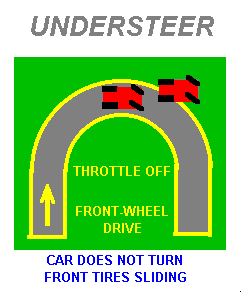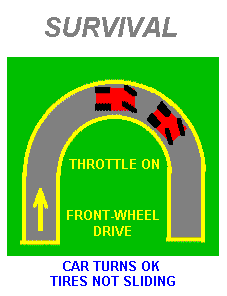DRIVING TIPS: WHAT THE GOVERNMENT WON'T TELL YOU
by John Lee

People who shut their eyes to reality simply invite their own destruction. --James Baldwin
As mentioned before, in front-wheel-drive cars, this problem of sudden loss of control occurs in a power-off situation. Therefore, the cure is to never allow a power-off condition to occur during a cornering situation. This can all but eliminate the problem.
There are two ways that a driver can accomplish this.
This first method feels very unnatural, contrary to common sense, and that is exactly why drivers never intuitively figure it out, especially in a panic situation. However, it works very well. It is simple, actually. By maintaining a "constant" throttle setting, the tires are able to function at their maximum cornering capacity. Most drivers have no idea of how much cornering potential their car really has -- on dry pavement (but routinely overestimate it in wet or icy conditions). By trusting the car to make it through the corner, and trusting their judgement on whatever speed was initially estimated, steering as smoothly as possible, the driver has the best possible chance to successfully navigate that corner. Note that any sudden change of the steering wheel will reduce the cornering ability of the tires; that's why it critically important to be smooth. Taking his foot off the throttle will only make matters much worse. If it is absolutely necessary to slow down, gentle application of the brake pedal will help, so long as the throttle is kept steady. It's a little tough on brake pads, but that's okay. Brake pads are much cheaper than a crash. Brakes are for slowing down -- the engine is for speeding up
Driver gets scared and tries to slow down by taking foot off the throttle pedal. |
Driver stays calm and in control, even when speeding up. |
This method of using the throttle when turning also applies when under heavy braking. Perhaps a car pulls out suddenly. The road is straight. The driver slams on the brakes, and takes his foot off the throttle to help slow down. That's fine. But when it comes time to dodge this obstacle, unless he puts his foot back on the throttle pedal, he can lose all steering. Even antilock brakes can't help, if the engine is also acting as a brake. Once the decision is made to turn, the gas pedal must be pressed, regardless of how unnatural it feels. Once again, this is why no one figures it out during a panic situation.
Sometimes actually accelerating with extra throttle power helps even more. This works even when the driver would prefer to slow down. But keep in mind the ultimate goal: the driver does not really want to slow down, the driver just wants to make it safely through the turn. Slowing down, by using engine braking, reduces the chance of surviving the corner. Paradoxically, when it comes to cornering, accelerating in a front-wheel-drive car is safer than slowing down. Some more observant drivers refer to this as "pulling the car through the corner," but trying to accellerate too much instead of balance can place the tires outside of the friction circle just as surely as too much decelleration (this is a rare problem).
Power-off understeer vs. power-on control. |
Once a driver learns the critical importance of maintaining a steady throttle, his car will behave predictably, like a rear-wheel-drive car. If needed to correct a "skid," (oversteer) the driver can apply "opposite-lock" steering, just as he would in a rear wheel-drive-car. Opposite-lock means steering in the opposite direction, in order to allow the front wheels to catch up to the back wheels. It is an emergency driving concept that has been long mentioned by government driving test booklets (but never experienced by students attending government driving schools).
The Tennessee Driver Handbook and Driver License Study Guide advises "Turn promptly in the direction of the skid. (Turn in the direction rear end of vehicle is sliding.)" Unfortunately, this advice simply does NOT work in a front-wheel-drive vehicle experiencing "power-off understeer."
The second method I have learned simulates how a front-wheel-drive car would behave if it had a clutching mechanism that disengaged during decelleration. It is very simple. Simply put the transmission into "neutral" when going through a corner. Modern brakes today are far superior to using engine braking to slow down. Let the brakes do their job. Never slow the car with the engine. The engine's job is to go, not stop. (This will also let the front tires last longer before wearing out, and also aid the longevity of the engine and transmission, as well.) Once again, this is one more thing to think about in an emergency situation, and it does not feel natural. This method has the advantage in that the driver is not required to press harder on the gas pedal, which can feel extremely unnatural. The gas pedal can be completely ignored, and all attention can be focused on getting through the corner. Once safely out of harm's way, shift back into gear and drive away (be sure to match the engine speed with the vehicle speed, so that the shifting is smooth). This method also works very well on cars with antilock brakes, allowing the braking computer to do its job without interference from the engine. Even the government recommends de-clutching (manual shift) or shifting into neutral (automatic transmission) when braking on ice or snow -- I extend this recommendation to cornering in FWD vehicles on dry or wet pavement.
The only exception to this rule is when traveling down a long mountain road, especially when carrying a heavy weight. In this case, the brakes can overheat and boil the brake fluid, since manufacturers do not build simple cooling air-ducts for their brake systems (at deadly expense to their customers). Keep the transmission in a low gear, and let the brakes cool off. Technically, the government has declared it a traffic violation to coast in neutral when driving downhill (coasting on a level grade or uphill is thus legal). However, remember that both air resistance (aerodynamic drag) and tire scrub (rolling friction) will usually be sufficient to limit maximum speed to a reasonable and safe level, equalizing the pull of gravity, usually not even reaching the arbitrary speed limit.
Keep in mind that the driver is the one ultimately responsible for making all decisions regarding his vehicle's safe operation, and is the one who pays the price for crashing, rather than the government.
Both of these methods take some getting used to, but are well worth learning. By practicing them in every cornering situation, a driver can develop an instinctive response that will take over when danger arises. They can save your life. If someone criticises this method, ask them to read this book, or perhaps ask them to get out of the car. Performed smoothly, most passengers won't even notice what you are doing. It doesn't make any difference whether the vehicle is manual transmission or automatic, although it is much easier for a floor-shift automatic than with a column-shift. Modern floor-shifters even eliminate the need to push the gear change button, when shifting from "drive" to "neutral." (Drivers of column-shift cars should use the throttle-accelleration method.)
I won't go into all the details of performance and emergency driving. There are plenty of good books available on that subject, available from book stores and automotive magazines. As mentioned previously, performance driving schools make great once-in-a-lifetime vacation destinations -- every bit as memorable as a Caribbean cruise or standing in line at Disney World -- and can truly teach life-saving driving techniques (which an average vacation can never do). All I will say is that in order for a front-wheel-drive car to steer, in any emergency situation, it must either have engine power going to the front wheels, or have the front wheels in neutral. So long as these rules are followed, the majority of accidental collisions should be avoided, with tens of thousands of lives saved annually, and hundreds of thousands of injuries prevented.
I would like to say a word about braking, and how to teach yourself how to get maximum stopping power in an emergency situation. Many drivers have crashes due to being unable to stop rapidly enough. Many drivers, when approaching a stopping situation, tend to slow down lightly at first, gradually increasing their foot pressure on the brake pedal until making a final sudden stop. It is as if they are afraid of losing control at higher speeds, by assuming (incorrectly) that the braking performance of the four tires improves at lower speeds. In a non-emergency situation, such as stopping for traffic lights, practice slowing down at a normal-but-steady rate. Without changing your pressure on the brake pedal, try to be completely stopped at the light. Not too soon, nor too late. Practice this racing-school exercise as often as possible, so that it becomes subconscious in a sudden emergency situation. In racing, smooth is fast. On the highway, smooth is safe.
If the wheels ever "lock up" under braking, such as on a rain slick road, just slightly reducing the brake pedal pressure will often be enough to get the wheels spinning again. You don't have to take your foot completely off the brake pedal, and then stab it again ("pumping"). Racing drivers never "pump" the brake pedal when the tires lock up. If you have antilock brakes, it is normal to feel a pulsation from the brake pedal; just keep your foot hard on the pedal without flinching; don't be afraid to press very hard on the pedal (many drivers with ABS are afraid to press the pedal hard enough). And remember, once a car skids sideways, anti-lock brakes have no benefit. Maximum braking performance is realized not with the tires locked-up or rolling freely, but when the tires are skidding ever-so-slightly. This knowledge can mean the difference between hitting the object to be avoided, or stopping five feet before contact.
|
























